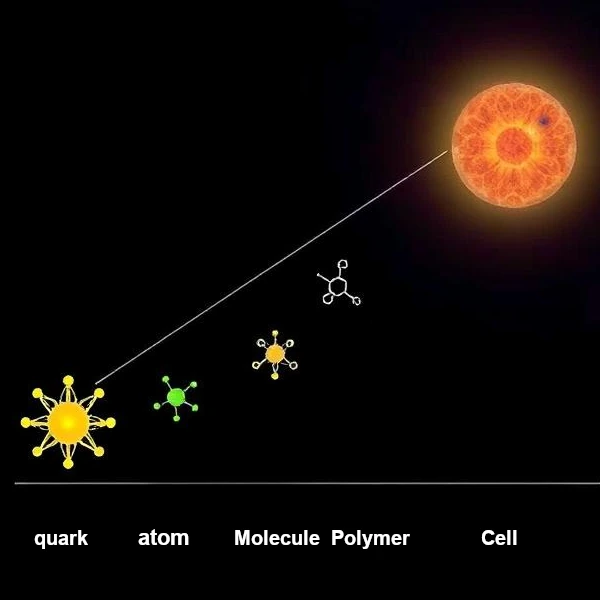
The story begins 13.8 billion years ago with the "Big Bang," when the expanding universe allowed the formation of the first elementary particles. Quarks and gluons, confined by the strong nuclear force, gave rise to protons and neutrons within a few microseconds.
George Gamow (1904-1968) and his colleagues showed in the 1940s that primordial nucleosynthesis (within the first 3 minutes) produced light nuclei: \(^{1}H\), \(^{2}H\), \(^{3}He\), and \(^{4}He\). Heavier atoms like carbon (\(^{12}C\)), essential for life, would only form much later in stars, as demonstrated by Fred Hoyle (1915-2001) with his famous triple-alpha process.
N.B.:
The triple-alpha process (discovered by Fred Hoyle in 1954) is the stellar reaction that produces carbon-12: \( 3 \times ^{4}He \rightarrow ^{12}C + 7.27 \text{ MeV} \). It requires a resonant state of carbon (Hoyle state at 7.65 MeV) and occurs in red giant stars (T > 108 K).
On the primitive Earth 4.5 billion years ago, conditions were radically different: a reducing atmosphere (CH4, NH3, H2O, H2), high temperatures, and abundant energy (storms, UV radiation, volcanic activity).
The historic experiment by Stanley Miller (1930-2007) and Harold Urey (1893-1981) in 1953 showed that these conditions could produce amino acids from inorganic compounds. More recent work, such as that by John Sutherland (1962-), revealed in 2015 plausible pathways for the synthesis of nucleotides, the building blocks of RNA.
| Period | Event | Temperature (K) | Complexity Achieved | Evidence/Experiments |
|---|---|---|---|---|
| 10-12 s | Formation of quarks | >1016 | Elementary particles | Standard Model, LHC |
| 3 minutes | Primordial nucleosynthesis | 109 | Light nuclei (H, He) | Observed cosmic abundance |
| 200 million years | Formation of the first stars | 104-107 | Heavy atoms (C, O, N) | Stellar spectroscopy |
| 4.5 Ga | Accretion of Earth | 2000-3000 | Differentiated planet | Isotopic dating |
| 4.4 Ga | Primitive oceans | 373-500 | Aqueous environment | Detrital zircons |
| 4.1-3.8 Ga | Prebiotic synthesis | 273-400 | Organic molecules | Miller-Urey experiment, Murchison meteorites |
| 3.7-3.5 Ga | First cells | 273-350 | Autocatalytic structures | Stromatolites, carbon isotopes |
Sources: Martin et al. (2016), Sutherland (2015),
The "RNA world" hypothesis, independently proposed by Walter Gilbert (1932-), Carl Woese (1928-2012), and Leslie Orgel (1927-2007) in the 1980s, suggests that RNA was the first molecule capable of both storing genetic information and catalyzing chemical reactions (ribozymes).
The "RNA world" hypothesis proposes that at the origins of life, ribonucleic acid (RNA) was both the carrier of genetic information and a chemical tool capable of accelerating reactions. Unlike DNA, which is more stable but "passive," and proteins, which are highly efficient but unable to store information, RNA could have fulfilled both roles, thus facilitating the emergence of the first living systems.
The spontaneous formation of RNA chains in a primitive environment was not straightforward: the bonds between its basic building blocks (nucleotides) easily break in water. Mineral surfaces or certain ions (such as magnesium) may have acted as "catalysts," helping these building blocks assemble. Temperature variations or humidity cycles may also have favored these reactions.
RNA is not just a data strand: it can also fold and form structures that accelerate chemical reactions, called ribozymes. These small "tools" made of RNA show that a single molecule could both contain information and act to reproduce it.
Faithfully copying an RNA strand is essential to maintaining a message. The longer the strand, the higher the risk of error. The first genomes therefore had to remain short or be organized into small cooperating fragments rather than a long fragile chain.
RNA adopts various shapes: helices, loops, knots... These shapes determine its capabilities: depending on how it folds, RNA can serve as a template for copying itself or act as a catalyst. Temperature, water, or salt concentration influence this folding.
Researchers imagine that the primitive Earth offered varied environments: clays, hot springs, lake edges subject to evaporation cycles. These places could concentrate molecules, stimulate their assembly, and favor the appearance of small systems capable of self-maintenance.
Instead of a single large "ancestor," life may have begun as a network of RNA fragments that helped each other copy and catalyze reactions. These cooperative assemblies may have overcome the fragility of isolated molecules.
Challenges remain: efficiently producing RNA building blocks under prebiotic conditions, showing that RNA can truly copy itself without help, and understanding how DNA and proteins later took over. However, the "first genome" hypothesis remains a fascinating avenue to explain how chemistry could have transformed into biology.
The transition from an RNA world to our current biochemistry based on DNA-proteins remains one of the major mysteries. Eugene Koonin (1956-) and his colleagues proposed in 2017 that this transition occurred via primitive viruses capable of transferring genes between proto-cells.
The first cells (LUCA - Last Universal Common Ancestor) likely date back to 3.8 to 3.5 billion years ago. Their metabolism was probably based on:
Phylogenetic analyses by William Martin (1957-) suggest that LUCA lived in alkaline hydrothermal environments (pH 9-11, 50-90°C), similar to the Lost City hydrothermal vents discovered in 2000 in the Atlantic.
Several major questions remain open:
This understanding of the emergence of life has profound implications: